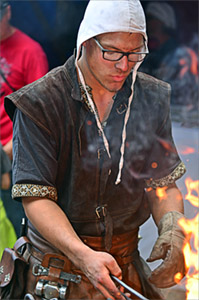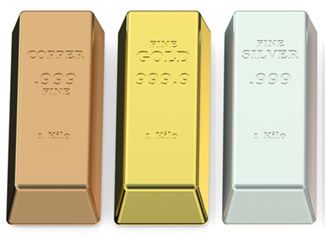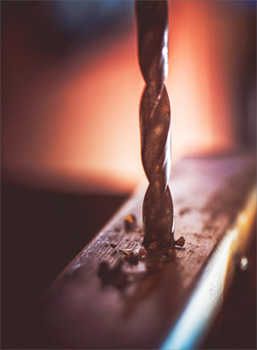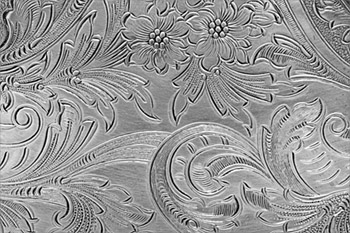 Historians often discuss historical events while connecting them with industrial advancements taken place during that time. These advancements include the Stone Age, Bronze Age, and Iron Age, discovered around 9000 BC, 2000 BC, and 1500 BC, respectively, in the Middle East.
Historians often discuss historical events while connecting them with industrial advancements taken place during that time. These advancements include the Stone Age, Bronze Age, and Iron Age, discovered around 9000 BC, 2000 BC, and 1500 BC, respectively, in the Middle East.
Understanding the evolution of metal cutting includes learning about metal properties and their numerous historical applications.
History states that the prehistoric man was familiar with six metals:
- Copper
- Tin
- Lead
- Gold
- Silver
- Iron
 He discovered that each metal had unique properties, therefore requiring different manipulation methods, and eventually, various end applications.
He discovered that each metal had unique properties, therefore requiring different manipulation methods, and eventually, various end applications.
For instance, he realized that gold and silver were softer than the other metals and used them for decoration purposes. He also realized that copper could be hardened by hammering and used to make tools.
Metal Cutting
A few factors come into play for metal cutting:
- Subject metal
- Cutting Tool
- Cutting Speed
- Chip Formation
- Force
- Energy Dissipated
- Desired Feeling of the Finished Surface
Metal cutting generally falls under the following categories:
- Chip Forming Method - Drilling
- Shearing
- Abrasive Material Removal Method - Grinding
- Heat Method - Laser Cutting
- Electrochemically
 Chip Forming Method - Drilling
Chip Forming Method - Drilling
Drilling is the process of cutting a circular hole into solid materials using a drill bit. The drilling bits come in different shapes and sizes, thus producing varying hollows on the metallic surfaces. The bits rotate and press against the workpiece at a high velocity. This drilling process results in chippings from the workpiece to eventually form the drill holes.
They also incorporate lubricants and other cutting fluids, ensuring smooth cutting. Other chip forming metal cutting processes include sawing and milling.
Shearing
Shearing has existed since the Bronze Age in the form of scissors that operated manually. It entails cutting a metal without using heat (burning or melting) and without the formation of chips.
Shearing involves using the cutting blades in a straight or curved manner. The process consists in having one moving part of the blade pushing the material onto the fixed counterpart. The two edges simultaneously apply pressure on the workpiece and eventually cut it.
Other shearing methods include punching and stamping.
Abrasive Material Removal Method - Grinding
Grinding is an abrasive process that involves using a grinding wheel machine to cut metal. Grinding is diversely used in the manufacturing and tool-making industries as it produces very smooth finishes, and can also produce mass quantities of roughly cut metal pieces as desired. It is used to cut hard metals and generates very accurate dimensions, as little as 13 micrometers.
Incorporate lapping, sanding, and polishing activities to smooth the materials further. It requires lubrication of the grinding wheel for cooling purposes and keeping the grinder working at peak performance. The chips produced should also be cleaned off before you resume working.
Heat Method - Laser Cutting
Laser cutting is a modern cutting technology that uses high-power laser beams to cut into materials. Commercial laser machines are programmed to cut into the metallic materials mechanically. When you direct the laser beam at the metal, it either melts, blows, or burns away to produce a desired high-quality end design.
The laser cutting machine was first introduced to the diamond drilling industry in 1965. The technology was later introduced in metal cutting in 1967, and into aerospace applications in 1970. Today, however, it is common to find laser cutting machines used in various schools, small businesses such as metal fabrication, and individuals.
The advantages of laser cutting over the typical mechanical cutting methods are many. One of the most apparent benefits is its versatility to be used on a variety of materials:
- Steel
- Aluminum
- Brass
- Gold
- Silver
- Rubber
- Plastics
Other advantages include precision cutting, the ability to cut through very thick materials, increasing mass production, reduced contamination of work pieces, and smooth operations.
Electrochemical Method - Etching
 Etching dates back to the Middle Ages and refers to the process of using strong chemicals to cut into metals. Traditionally, goldsmiths and other metal-workers would decorate metallic items such as armors and guns.
Etching dates back to the Middle Ages and refers to the process of using strong chemicals to cut into metals. Traditionally, goldsmiths and other metal-workers would decorate metallic items such as armors and guns.
These men would cover a metallic plate (whether copper or steel) with an acid-resistant wax, scratch off the wax into the desired motif using an etching needle, then immerse the plate into an acid bath. The acid would then “bite” into the exposed metal to produce a carving of the drawn motif. The depth of the print depended on the duration of immersion.
In modern times, however, electroetching has been introduced to avoid the side effects of traditional etching. Some of these side effects include the burning of the skin and damaging of the metallic plate. Electroetching involves using an electrolyte solution, an anode, and a cathode to etch onto the metal.
Other metal cutting methods that use heat include flame cutting and plasma cutting that use oxygen-fueled flames and hot plasma, respectively.
In Sum
As time keeps changing, so does technology. Incorporating laser cutting machines into your business improves efficiency and ensures consistent, higher quality.